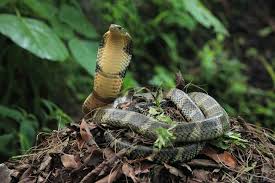In an alarming turn of events, ten highly venomous snakes—including nine king cobras and one monocled cobra—have been discovered in and around Kathmandu within just a month. These deadly reptiles, typically found in hot, humid environments such as swamps, paddy fields, and mangroves, were shockingly located a mere 160 kilometers from Mount Everest—a region known for its cold, high-altitude climate. Experts say this is no isolated incident but a clear warning sign of the escalating impact of global warming.
Unnatural Sightings in Unlikely Terrain
The king cobra (Ophiophagus hannah), the world’s longest venomous snake—capable of reaching lengths up to 18 feet—is rarely seen outside its natural tropical habitats in India, Southeast Asia, and the Philippines. Likewise, the monocled cobra (Naja kaouthia), recognized by the distinctive circular marking on its hood, is also a tropical species.
The recent discovery of these snakes in areas close to the Himalayan region has left experts and residents stunned. Their presence in higher altitudes is being seen not as a random event but as part of a broader ecological shift, potentially driven by rising global temperatures.
Residential Panic and Ecological Clues
Reports from The Kathmandu Post state that the snakes were found in residential neighborhoods such as Bhanjyang, Gupaleshwar, Sokhol, and Phoolchowk. Locals encountered these dangerous snakes in courtyards and homes, prompting emergency rescue efforts. While the reptiles were safely captured and released into nearby forests, deeper forest investigations have revealed snake nests and eggs—suggesting these species may now be settling and even breeding in the region.
Scientists: Climate Change Is Redrawing Habitats
According to environmental scientists, the shift of venomous snakes to higher altitudes is likely not a result of random migration but a response to changing environmental conditions. Nepal’s mountainous regions are warming at an alarming pace—research indicates that hill and mountain temperatures are rising at approximately 0.05°C per year, outpacing warming rates in the low-lying Terai region. This is creating warm microclimates in areas once considered inhospitable for tropical species like the king cobra.
“This isn’t just a warning for Nepal,” said one researcher. “This is a global signal that climate change is altering ecosystems faster than many species—and humans—can adapt.”
An Alternative Theory: Accidental Relocation
Not all experts are attributing the phenomenon entirely to climate change. Snake rescue instructor Subodh Acharya proposed that some of these reptiles may have been accidentally transported from the Terai region to the hills via trucks carrying goods such as firewood or hay. While this theory cannot be ruled out, the discovery of nests and breeding signs strongly suggests the snakes are adapting to their new environment.
Persistent Dangers in the Terai
Even as high-altitude sightings draw attention, scientists warn that the snakebite crisis in the Terai lowlands remains dire. Each year, an estimated 2,700 people die from venomous snakebites in southern Nepal, with women and children making up the bulk of victims. This ongoing public health challenge underscores the broader threat snakes pose—regardless of habitat shifts.
A Warning We Cannot Ignore
The unexpected appearance of king cobras near Mount Everest is more than a startling anomaly—it’s a stark indicator of changing climates and ecosystems. Whether driven by warming temperatures, human transportation, or both, these incidents demand immediate attention.
As venomous snakes move into new territories, communities must prioritize both climate action and adaptive safety measures. This is not merely about snake sightings—it’s about an evolving natural world and our collective responsibility to respond with urgency, awareness, and preparedness.






